October 15, 2013
October 18, 2013
March 26, 2013
October 26, 2011
October 24, 2011
March 10, 2011
December 3, 2010
January 18, 2010
January 05, 2010
May 11, 2009
March 01, 2009
Febuary 14, 2009
December 30, 2008
December 26, 2008
September 29, 2008
June 25, 2008
March 01, 2008
january 05, 2008
JULY 11, 2007
JULY 11, 2007
June 18, 2007
June 18, 2007
Febuary 16, 2007
Febuary 08, 2007
December 08, 2006
October 18, 2006
June 28, 2006
June 27, 2006
November 27, 2005
|
|
MAY 11, 2009
Visions Of Excess
By Michele Occelli
VISIONS OF EXCESS.
London is an archetype and its own interzone. It is gas lit architecture, yellow flame hues, silhouettes casting shadows against walls made of brick and moss that arch themselves upward, as if an overgrowth, a petrified forest, a recoil from light and sky. London is indoor, underneath, forever escaping the open air. London is the experience of history as hiding, of the unpresented, of the intestinal, the visceral, the belly, and of course, the cut that goes so well with it, the slash, the blood, the gloved Victorian hand that never frets, even when at it, even within the abominable.
On the 12th of April of the year 2009, presented as a '12 hour communion with the ragged spirit of Georges Bataille exploring the "scatological philosophers" key themes of death, eroticism and the forbidden' - in the underground location of Shunt, beneath London Bridge, your envoy witnessed the unfolding of VISIONS OF EXCESS.
The viewer was invited to 'enter' from the gleaming surreal sphincter of London bridge station, one more stop into the grand history of contemporary architecture as plastic surgery, where the wrinkled beauty of history is flattened by the hygienic blade of functionality's surgical knife. Once inside, suspended in a labyrinth of chaotic intensities, the passerby was to find him/herself forced into a sensual descent towards the voluptuous embrace of an ever more uncomfortable closeness with the distorted visions, perversions and the ornate babbling psychopathological lullabies of a bunch of contemporary artists, an horde of lost souls under the iron hooks of captain Ron Athey and Lee Adams. Passing through the digestive system of the night's architecture, the audience was to be shat out the morning after into the dingy road tunnel at the venue's exit, the stark real London underbelly to a mystified London-to-be beginning.
If you want an image of the future, imagine a boot stamping on a human face, forever. And it is Art that should be a boot, stamping on the very possibility of that image. Visions of Excess was a night. And if the night itself could be housed, it was the very visceral architecture that would result in such effort. It was a system of punctuation extended over a period of 12 hours as the very attempt to re-present to us a space for the contemplation of those mysteries whose unfolding collapses the boundaries between articulate and inarticulate, immanent and transcendent, thinkable and unthought.
The performances had been distributed across Shunt's Victorian decay of arches and corners, with its constant verging on the Escheresque, that insistent presence of dead ends and detours, the almost deafening reiteration of the simple fact that going from a to b is not really, and never should be, such a simple matter. The mesh of spaces and acts was razor-blade balanced by the presence of David Hoyle leading the crowd of onlookers along a Bataillean Way of the Cross - no Saviour in sight under the smear of heavy make up, the walls tattooed with the treacle of sexual excess conjuring a more amusing even though not any less whipping sense of the miraculous.
On our left, Franko B's I'm Thinking of You. A child's sling abandoned with precision in one of the first arches, visually stilled by the brickwork frame, an empty lit space filled with an hypnotic reworking of Satie's atavic piano compositions. On the sling, as if lost in a corner of his own dreamscape, between pleasure and estrangement, bliss and incertitude, a naked Franko, gently rocking, engaging with the audience with a smile, occasionally blowing kisses at some. The child-like suspension of the whole space potently cast the experience into that uncomfortable familiarity of the infantile where the sexual is never alone, never resting, always mixed, always jouissant. Where genitals and talk powder embrace each other, one indissolubly bound to the other, as if a collapsed metaphor of how purity and impurity can never truly be taken apart. A gate into further deviations, it surprised us with the fondness of its gentle topography, like a caress that gets you ready for a slap.
Across the darkness, Ron Athey glowed into Self-Obliteration. It would be a criminal act to describe Athey's performance as a sum of factual and visual instances. The expression on the artist face as the performance climaxed reminded us of the transcendence that is carved into the ecstatic gasp of Berninišs Saint Teresa; and there is no phrenological quickie to bypass the actual experience of viewing it. Athey's achievement was profound, sacral. He shifted desire from within himself into an entirely self-generated system, made of the bind between the body of the artist and the collective body of its audience. And within this system desire was made to play the role of the internal limit, the visceral centre, the zero point. The objective power of hesitation of the body alighted Athey's expression with the fear and trembling which is of all being, that languid vibrato that tunes life into death, made the viewers face an epiphanic collapse, a proximity of intensity rather than positioning, with a fundamentally chaotic outside, an outside, an Other, a depth of subjectivity 'more distant than any external world because it is an inside deeper than any internal world'. I have seen solar eclipses silencing an unkindness of ravens, I saw an artist plunging men into the gasp of transubstantiation.
It is hesitation that was for us the most encompassing theme of the night: as fundament of both ecstasy, death, and birth, as the sexual thought of being, and its coming, always silent, always hesitant. A night cut by the line between utterance and silence, stillness and act, trembling with the stutter of the cosmos as its inmost fragility, its kindest gesture. Hesitation as the peristalsis that magnifies the unbearable presence of the soul into the body - the ontological burrow that is life's darkest thought.
Suspended over fizzing VITROL, Lee Adams burned away above our heads, performing a genealogical autopsy, autos + opsis, the act of seeing with one's own eyes. Oscillating between Mickey Mouse and L'Acephale, between past and back-to-the-future, wrapped in a Lorcan Duende of symbological atrocities, the artist reminded us of the very coming into being of the European psyche, from the Victorian's panoptical anxiety with being buried alive to the particularly actual necessity for disconnection and misrecognition that our culture requires in its survival and constant search for economic regeneration. The Spectre of Mickey Mouse is haunting our present and it is precisely its Prozac semiotics which beheads meaning off the body of our society. The result, obscurity as the death of all flames, extenuating, unresolved, a lingering flicker that howls into the night.
Clustering around us were innumerable other performances, making Visions of Excess a thread, a fabric, a texture, a proximity of events, whose intensity induced a state of crisis capable of upsetting the coherence of our subjectivity setting its constituent components into dialogue with the elements of the world. The common ground binding both Athey's and Adams' visions being the absolute necessity to use art as a force that destabilizes not the individual as such, but the very structure that underlies our world. It was iconic spatiality distributed across a landscape of bodies and the very potential for metamorphosis that the human retains when it hesitates, left paw by right paw, into its non-human other.
It was the night as Khora: that which is neither sensible nor intelligible, but belongs to a third genus. One cannot even say of it that is neither this nor that or that it is both this and that. And, of course, the performances became stillness and the stillness the dancing. As eventually the cross-shaped central cave of the venue was turned into the temple of a tekno injected jardin des supplices, savagely mixed by the talents of DJs Dr. Mu, Franko B, and Chorozon. Completing the transformation initiated hours before, the energies gathered by the participants throughout the night were unleashed, let free, manifested unto the immanent plane, into the concrete act of dancing. A generative act returning craft into the hands of the audience. As Plato writes in the Timeus, the khora is that which renders definition superfluous, the site where the symbolic hierarchy of language is suspended. Visions of Excess defies our conceptual framework, the stability of reason and its dire principle of non-contradiction. It defies the very act of attempting at a review. It makes these words of mine superfluous. Its landscape, this night that is the night, night of all nights, becomes a cloak drenched into the blood smeared rapture of magic, a hoof pounding sound still resonating in our head as the very cyclical impossibility to understand where an experience ends and another begins, where, still, we were lost and suspended into the shriek of a beauty that could only be convulsive, or not at all.
Michele Occelli.
Links
MICHELE OCCELLI
RICHARD J. ANDERSEN
|
|
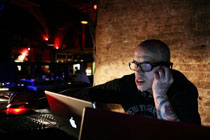
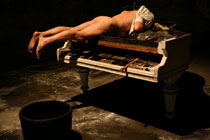
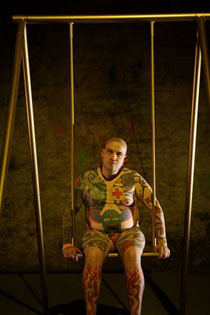
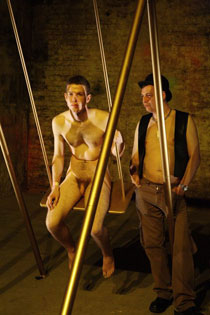
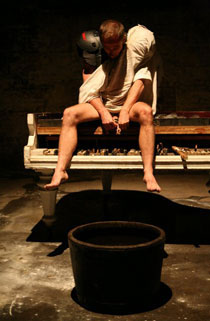
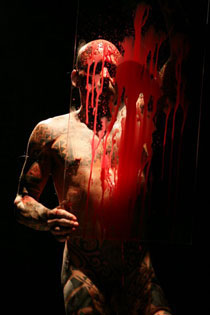
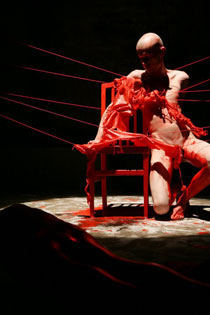
PHOTO: RICHARD J. ANDERSEN
|
|
|

